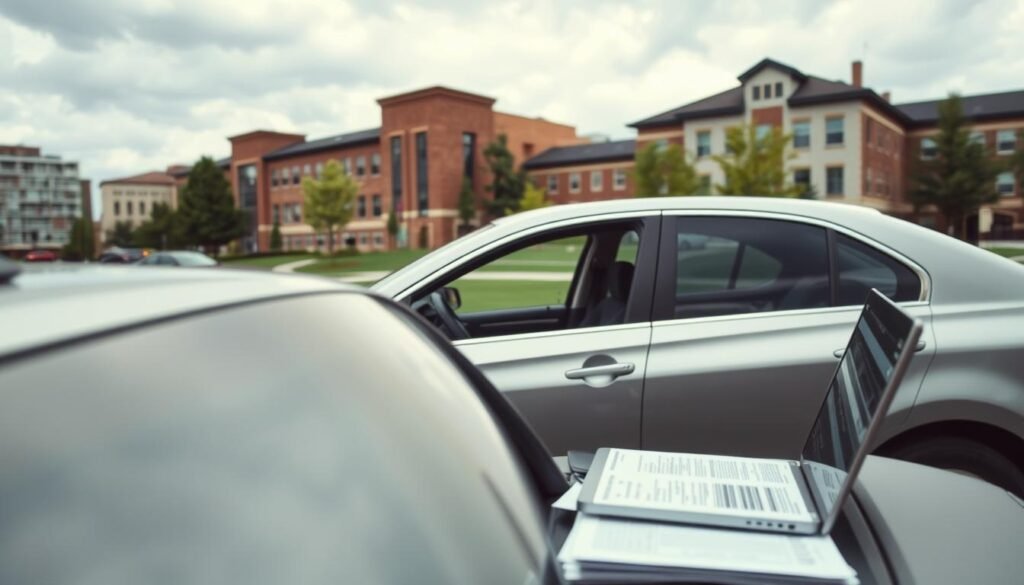
Find the Best Car Insurance for Graduate Students USA

"The beautiful thing about learning is that nobody can take it away from you." — Malcolm X.
You are juggling classes, research, and a tight budget. This guide helps you find sensible car insurance with affordable rates and real student discounts.
We compare top names like Geico, State Farm, Progressive, Auto-Owners, Allstate Milewise, American Family, and USAA so you can see which fits your life now.
You’ll learn typical costs on a parents policy versus your own policy, how usage-based programs and pay-per-mile work, and which discounts actually lower your premium.
Quick wins: update your garaging address, check good-student breaks, and verify bundle discounts. By the end, you’ll know which coverage to keep and which extras to drop.
- Why car insurance costs more for college and grad students right now
- Best car insurance companies for students: top picks and why they stand out
- Coverage options that matter for students on a budget
- Should you stay on your parents’ car insurance or get your own?
- car insurance for graduate students USA: discounts you can stack
- What students actually pay: current benchmark rates and examples
- How to compare quotes and find affordable rates fast
- Living situations that affect your premium while in college
- Common pitfalls to avoid when insuring a student car
- Your next steps to lock in the best car insurance for students
Why car insurance costs more for college and grad students right now
Premiums climb during college years largely because you have less driving history. Insurers rely on age and claims data, so young drivers often face higher rates until they build a clean record.
How insurers view risk
- Limited years behind the wheel and sparse claims history make you a higher risk in underwriting models.
- Where you park most nights matters: changing your garaging ZIP while at school can raise or lower your policy price.
- Many families keep students on a parents policy because it spreads risk across older, more experienced drivers and multiple vehicles.

Data shows premiums fall notably as you gain experience. MoneyGeek reports typical drops of 30–40% from freshman to senior year, and rates often become competitive by age 21.
Options like usage-based tracking and pay-per-mile can reward low-mileage college students with lower premiums. Also, verified good grades may unlock a student discount that offsets age-related pricing.
Best car insurance companies for students: top picks and why they stand out
These insurers stand out for student-friendly discounts, telematics plans, and low-mileage options.

- Geico is a go-to if you want straightforward savings. It offers up to a 15% good student discount, breaks for leaving your vehicle at home, and several add-ons like roadside and rental reimbursement.
- State Farm rewards grades and safe driving heavily. Good student can reach 25% and Drive Safe & Save may shave up to 30% off your premium.
- Progressive helps if you leave your car on campus most of the year. You can pause collision while keeping comprehensive and add features like rideshare coverage.
- Auto-Owners posts competitive rates when you need your own policy. It has teen telematics, accident forgiveness, gap options, and a good student discount up to 20%.
- Milewise by Allstate is ideal if you drive very little. It uses a daily fee plus per-mile charges and caps on daily miles in several states.
- American Family works well for higher-risk young drivers, offering gap coverage, volunteer discounts, and bundles that can lower rates.
- USAA gives top value if you qualify through military ties, with SafePilot Miles and strong bundling discounts.
- Match each company's strengths to your lifestyle: living on campus, low miles, good grades, or needing gap coverage.
- Compare quotes apples-to-apples and verify student discounts before you choose a policy.
Coverage options that matter for students on a budget
Choose protections that shield you from big bills without bloating your monthly cost.
Bodily injury and property damage limits: Start with sensible liability limits like 100/300/100. These limits help protect your savings if you cause a serious crash. They exceed minimal state requirements and lower your risk of an uncovered lawsuit or repair bill.
Bodily injury and property damage liability limits to consider
100/300/100 is a solid baseline used in many comparisons. If you have assets to protect, raise limits. If money is tight, avoid the state minimums unless you have no choice.
Collision and comprehensive: when to keep, when to drop
If your vehicle is older and paid off, dropping collision can save money. Keep comprehensive if theft or hail is a risk where you live.
Remember lenders usually require both comp and collision until you finish payments.
Usage-based, accident forgiveness, and gap add‑ons
Telematics programs can cut rates if you drive little State Farm Drive Safe & Save and USAA SafePilot offer up to ~30% at renewal. Progressive Snapshot may raise rates if habits look risky.
Accident forgiveness varies: Auto-Owners and Progressive offer add-ons, while State Farm requires years of clean driving and Geico’s program needs about five accident-free years.

| Feature | Available Carriers | Notes |
|---|---|---|
| Accident forgiveness | Auto-Owners, Progressive, Geico, State Farm | Auto-Owners and Progressive offer add-ons; Geico after ~5 years; State Farm needs ~9 accident-free years |
| Usage-based discounts | State Farm, Progressive, USAA, Allstate Milewise | Up to ~30% with State Farm/USAA; Milewise charges per mile in 18 states; Snapshot can increase rates |
| Gap coverage | Auto-Owners, American Family | Not offered by Geico or State Farm; essential if you owe more than vehicle value |
| Collision drop option | Progressive noted | Good choice on low-value paid-off vehicles; lenders typically prohibit this |
- Match deductibles (e.g., $500) when you compare quotes.
- Review coverage annually as your driving and vehicle value change.
Should you stay on your parents’ car insurance or get your own?
Decisions about coverage hinge on where you park, who owns the vehicle, and how permanent your move is.
If your parents’ home stays your permanent address and you only drive when home on breaks, you’ll often save by staying on a parents policy. Carriers like Progressive typically allow this setup, and being listed pools your risk with older drivers.
When staying on a parents policy saves you money
Keep the policy if you garage the vehicle at your family home, are listed as an occasional driver, or qualify for a distant student break when you live 100+ miles away. This keeps many student discounts intact and usually lowers premiums.
When you need a separate policy
You need your own auto insurance when you change your license address, live off‑campus most nights, or finance the vehicle. Also get a solo plan if your new ZIP has lower rates your quote might be cheaper on its own.
- Confirm with your carrier whether the car is taken to campus and where it’s garaged.
- Compare quotes with matching limits before switching so you don’t lose discounts or coverage.
car insurance for graduate students USA: discounts you can stack
Combining academic and lifestyle discounts often yields the biggest price drops on a policy.
Good student breaks typically range from about 5% to 25% depending on the carrier. State Farm lists up to 25%, Geico about 15%, USAA up to 10%, and Auto-Owners or Allstate may offer around 20% for solid grades.
Pair a good student credit with a distant student break if you leave your vehicle behind while at school more than 100 miles away. Then add defensive driving or driver education discounts where eligible.
- Ask about organization discounts (Greek life, honor societies, campus groups).
- Volunteer 40 hours to qualify for American Family’s community saver.
- Bundle renters and auto to capture multi-policy savings USAA and others offer notable reductions.
- Service members and ROTC can stack military-related discounts with academic breaks at Geico and USAA.
Tip: Keep transcripts handy. Insurers verify good grades each term. If you stay on a parents policy, confirm which discounts still apply and whether taking a vehicle to campus changes eligibility.
"Stacking small discounts correctly can cut your annual premium by a third or more."
What students actually pay: current benchmark rates and examples
Real-world rate snapshots show a wide gap between staying on a family plan and carrying your own policy.
Benchmarks: CNBC Select reports adding an 18–21-year-old to a parents policy averaged about $1,610 in 2024, while an individual policy averaged $4,689. MoneyGeek confirms family policies tend to be cheaper and that many college students save roughly $288 a year by staying listed with parents.
| Carrier | 18 on parents | 21 on own |
|---|---|---|
| Geico | $3,210 | $5,098 |
| State Farm | $4,215 | $6,312 |
| USAA | $3,333 | $3,995 |
What this means for you
Expect a big gap: parents policy vs. your own can differ by thousands. Rates typically fall 30–40% by age 21 with a clean driving record and a verified good student credit.
- Full coverage on a newer vehicle raises premiums; compare $500 vs $1,000 deductibles closely.
- State minimum cuts price but can leave you exposed after a serious claim.
- Run same-day quotes and match coverage line-by-line to pick the best policy for your situation.
How to compare quotes and find affordable rates fast
Start your quotes with the ZIP where the vehicle sleeps; local risk models drive most pricing. Gathering accurate, ZIP-based quotes makes your comparisons real instead of hypothetical.
Match coverage exactly. Ask each insurance company for a 100/300/100 full‑coverage quote with the same deductible, such as $1,000. That ensures you compare apples to apples and spot true rate differences.
Verify every student program and discount before you assume it's applied. Good‑student credits, distant‑student breaks, and organization discounts often require transcripts or proof of enrollment.
Leverage telematics and low‑mileage programs
Explore Drive Safe & Save and SafePilot if you drive little; both can cut renewal rates up to ~30%. Read terms first: Progressive Snapshot can raise your premium if driving looks risky.
- Consider Allstate Milewise when campus life keeps mileage low its daily base plus per‑mile fees cap daily tracking.
- Decide on collision coverage and deductible levels up front to see real premium impacts.
- Gather at least three quotes, re‑quote after moves, and keep transcripts handy to activate discounts fast.
"Compare with the same limits and deductibles small differences hide big price gaps."
Small moves and parking choices can change what you pay.
Where you garage the vehicle matters most. Changing dorms, signing an off‑campus lease, or leaving a student car on campus can shift your rates mid‑term. Insurers re‑rate policies based on the ZIP where the vehicle sleeps.
Many carriers let you stay on a parents policy while attending school out of state if your permanent address stays with family. Progressive notes this in most states, but always confirm with your carrier.
Out‑of‑state attendance and distant student rules
If you attend school 100 miles or more from home and leave the vehicle behind, you may qualify for a distant student discount. These programs usually require you not to regularly drive the vehicle while away.
- Be listed on your parents policy if you drive their vehicle during breaks failure to list can create gaps in coverage.
- If you permanently move and garage the vehicle near campus, insurers typically require a policy tied to that new address.
- On‑campus vs. off‑campus living changes theft and accident risk profiles; ask for a re‑rating when your housing changes.
| Situation | Common Carrier Response | Action to Take |
|---|---|---|
| Out‑of‑state, permanent address stays home | Often allowed to stay on parents policy | Confirm with insurer and document permanent address |
| Distant student (100 miles+) leaves vehicle at home | May qualify for distant student discount | Verify rules and avoid regular use while away |
| Permanently moves near campus and garages vehicle there | Must add or switch to local policy | Obtain quotes with new ZIP and update license if needed |
| Occasional use of parents car during breaks | Must be listed to maintain coverage | Ask parents to add you as occasional driver |
"Tell your insurer when your housing or parking changes. That keeps discounts valid and avoids surprises at claim time."
Common pitfalls to avoid when insuring a student car
A few simple oversights often lead to denied claims or lost discounts.
Update your garaging address. Use the ZIP where the vehicle sleeps. The wrong location can cause a denied claim and wrong rates.
Match limits when you compare quotes. Line up bodily injury and property damage liability and the deductible. A low price with weak limits may cost much more after a serious crash.
Think twice about telematics. Programs like Snapshot can lower renewal costs for safe driving but can raise rates if you brake hard, drive late, or use your phone.
- Don’t drop collision coverage on a financed vehicle your lender usually requires it.
- If you leave a vehicle at home, keep comprehensive to cover theft or storm damage while you’re at school.
- Verify gap availability if you owe more than a vehicle’s value; some carriers do not offer gap.
- When you drive a parents car during breaks, be listed on the parents policy to avoid denied claims.
- Resubmit transcripts and proofs at renewal so student discounts stay active.
"Small documentation and address checks help you keep discounts and avoid nasty surprises at claim time."
Your next steps to lock in the best car insurance for students
Start by choosing whether to stay on a parents policy or move to your own based on where the vehicle sleeps most nights.
Gather three to five matched quotes using the same limits (like 100/300/100) and deductible so you compare true rates. Ask each insurance company about good student and distant‑student discounts, bundling, and telematics or pay‑per‑mile options if you drive little.
Include USAA if eligible, check Geico for family plans, and get a State Farm quote if you want individual pricing. Verify your parking ZIP, keep transcripts and proof of distance, then lock the chosen policy online or with an agent and set a renewal reminder.
If you want to know other articles similar to Find the Best Car Insurance for Graduate Students USA you can visit the category Finance.






Leave a Reply